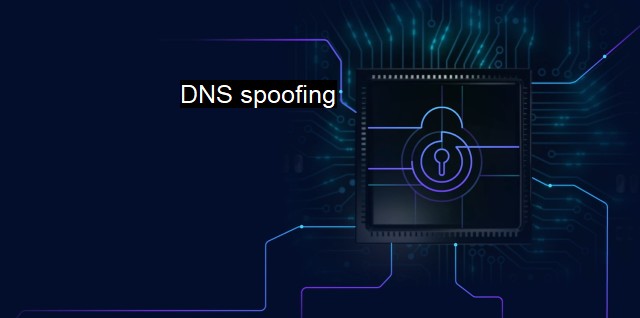What is DNS spoofing?
Understanding DNS Spoofing: A Common Cyberattack and its Implications on Internet Security
Domain Name System (DNS) Spoofing, also known as DNS Cache Poisoning, is a form of cybersecurity attack where intruders mask or falsify information in the DNS system, causing the name server to return an incorrect IP address, effectively diverting the traffic to the attacker's computer. Aspects of our everyday Internet are grounded on our reliance on the DNS to facilitate the translation of human-readable domain names into machine readable Internet Protocol (IP) addresses. As such, manipulations in the DNS process can lead to serious security breaches.Computers communicate using series of numbers and codes that would be extremely complex for humans to remember. Therefore, the DNS was designed as a database that would allow more user-friendly interaction with the internet by facilitating the transformation of complicated IP addresses to more accessible domain names. When you type a URL into the address bar of a browser, the computer will make a request to the DNS server. It then receives an IP address corresponding to the URL and ideally, takes you to the desired website.
DNS Spoofing comes into play when cyber criminals intervene during this process. They manipulate the DNS server responses by feeding false information so that users are redirected to fake and malicious websites. As soon as the users enter their private data unknowingly into these sham sites, hackers can exploit this information, resulting in severe security risks like identity theft, stalking, or even financial loss.
To perform DNS Spoofing, attackers need to have the right set of skills and tools, including Packet sniffers, a suite of software used for tampering with DNS server’s cache and packet routing, which fools users into visiting malware-laden sites. With this manipulation, the intruder gains complete control, typically leading to the victim’s personal information being exploited, introduction of malicious software into the victim’s system, or even blocking the victim’s access to particular web services.
From a cybersecurity and antivirus standpoint, the detection and prevention of DNS Spoofing is critical. Intrusion prevention systems (IPSs) can offer a reliable security mechanism to counter DNS Spoofing. IPSs can catch DNS queries with spoofed answers and block them from entering the network. Regular patrolling and scouting for strange traffic patterns also assists in detecting potential DNS Spoofing.
Implementing DNS Security Extensions (DNSSEC) can add an extra layer of security. DNSSEC responds to the vulnerabilities associated with DNS by providing a way for DNS responses to be verified for their authenticity and integrity. remember that DNSSEC is not a silver bullet, as it cannot prevent all DNS attacks but can offer added security.
DNS-based firewall services that restrict geographical regions and enforce your web-policy can also provide substantial protection against DNS spoofing. Geofiltering enables alerts when attempts from unauthorized regions exploit your DNS systems and vital infrastructure, mitigating the risk associated with DNS attacks.
Constantly updating patches, employing a secure VPN and deploying typical malware prevention tools like antivirus software or services mitigate the risk of falling victim to a DNS Spoofing incident.
To summarize, DNS Spoofing is a convoluted cybersecurity hoax where hackers take citizens of the internet world hostage by guising as legitimate websites and transactions. They trick users into surrendering confidential information to their malicious ventures, potentially leading to disastrous outcomes. Given the serious risks, it emphasizes the importance of maintaining up-to-date cybersecurity measures including a reliable antivirus system to safeguard our digital habitat.

DNS spoofing FAQs
What is DNS spoofing?
DNS spoofing, also known as DNS cache poisoning, is a malicious technique that involves altering the Domain Name System (DNS) records in order to redirect internet traffic to a fake website or IP address.How does DNS spoofing work?
DNS spoofing works by exploiting a vulnerability in the DNS protocol. Attackers send malicious DNS queries to the target system, which then unknowingly caches the fraudulent DNS records. When the user tries to access a legitimate website, their request is instead directed to the attacker's fake website.What are the consequences of DNS spoofing?
DNS spoofing can have serious consequences, such as stealing sensitive information like login credentials and financial details. It can also compromise the integrity and reliability of the targeted system or network, leading to reputational damage and loss of revenue for businesses.How can I protect myself from DNS spoofing?
To protect yourself from DNS spoofing, you can use tools like antivirus and virtual private networks (VPNs) that encrypt your traffic and prevent attackers from intercepting it. You can also configure your DNS settings to use a trusted DNS resolver or enable DNSSEC, a security protocol that add a layer of validation to DNS records.| | A | | | B | | | C | | | D | | | E | | | F | | | G | | | H | | | I | | | J | | | K | | | L | | | M | |
| | N | | | O | | | P | | | Q | | | R | | | S | | | T | | | U | | | V | | | W | | | X | | | Y | | | Z | |
| | 1 | | | 2 | | | 3 | | | 4 | | | 7 | | | 8 | | |||||||